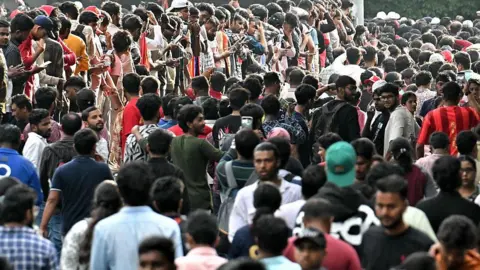On June 4, 2025, a tragic incident occurred outside the Chinnaswamy Stadium in Bengaluru, India, leading to the deaths of at least ten individuals due to a stampede. This catastrophic event took place during a victory parade celebrating the triumph of the Royal Challengers Bengaluru (RCB) cricket team, which had recently clinched the Indian Premier League (IPL) title by defeating the Punjab Kings. It was a moment supposed to be filled with joy and celebration, but instead, it ended in chaos and sorrow.
Thousands of enthusiastic supporters gathered to welcome their home team, creating a vibrant yet crowded atmosphere. Witnesses reported that the streets were lined with fans of all ages, eager to show their admiration for RCB. As celebrations unfolded, a police official confirmed that the pressure on the stadium gates became overwhelming. “About 10 people have died in the stampede at the gates of the Chinnaswamy stadium,” stated the official when speaking to BBC Hindi. Eyewitness accounts highlighted that the gates had not even opened yet when the crowd surged forward, resulting in the deadly crush.
The situation escalated rapidly, underscoring significant issues regarding crowd control and event management. One police official remarked that the crowd estimated to be over 200,000 was far greater than the expected attendance of approximately half that number. The RCB players had arrived at the old HAL airport in Bengaluru via a special flight, greeted by the Karnataka Deputy Chief Minister, DK Shivakumar. Subsequently, they were escorted in a procession, which was originally part of the day’s festivities leading up to a formal reception at the Vidhana Soudha—the seat of the state legislature—where Governor Thawarchand Gehlot, Chief Minister Siddaramaiah, and other officials awaited them.
As the excitement mounted, large masses of supporters, donned in RCB jerseys, made their way toward the stadium using various modes of transportation. Reports detailed how metro trains were overcrowded, leading many fans, including journalists, to be unable to enter any compartments. Throughout this journey, supporters chanted the team’s name, creating an electric atmosphere. Meanwhile, auto-rickshaws and taxis were scarce, with many drivers refusing rides close to the stadium, forcing fans to walk several kilometers instead.
Prior to the crush that claimed lives, the celebration seemed to take a festive turn. However, as news of fatalities spread among the crowd, panic ensued, prompting many to hastily retreat toward metro stations. In a bid to manage the swelling crowd, authorities promptly shut down stations surrounding the stadium due to the overwhelming number of individuals congregating on the platforms.
This tragedy not only highlights the dangers associated with large public gatherings but also serves as a call for improved safety measures. It draws attention to the necessity of comprehensive planning for crowd management at significant events, particularly in sports. The unfortunate events of that day will likely resonate throughout the community and spark discussions regarding the need for developing adequate safety protocols to prevent such incidents in the future.
As the city and the nation mourn the loss of life, it is a poignant reminder of the fine line between celebration and chaos, illustrating the darker side of massive public gatherings. Many citizens and officials are left grappling with the ramifications of this calamity, seeking answers and accountability to ensure the safety of fans during future events.
The victory parade was intended to be a proud moment for the Royal Challengers Bengaluru and their supporters; instead, it became an occasion marred by loss and heartache, demanding a thorough investigation and compassionate response from authorities to prevent any recurrence of such tragedies.



